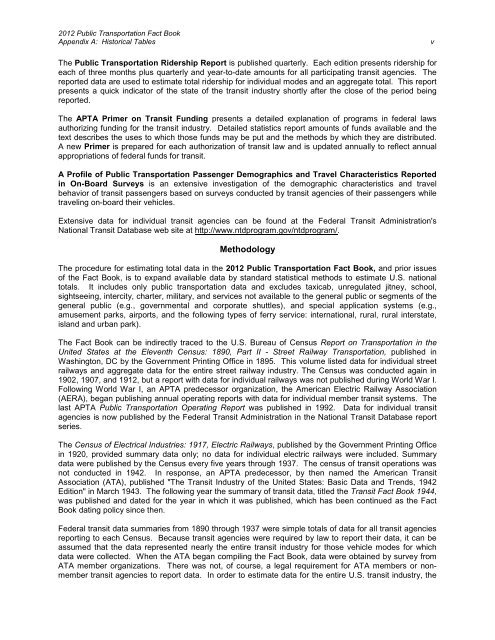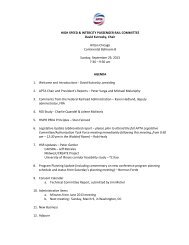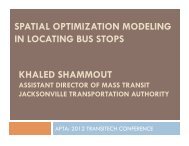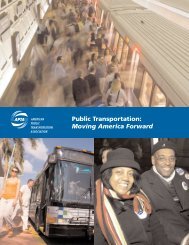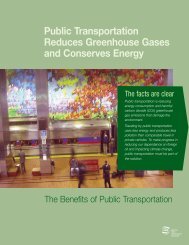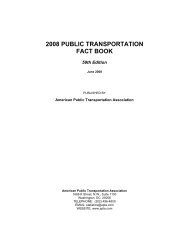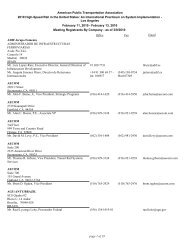2012 APTA Fact Book Appendix A - American Public Transportation ...
2012 APTA Fact Book Appendix A - American Public Transportation ...
2012 APTA Fact Book Appendix A - American Public Transportation ...
You also want an ePaper? Increase the reach of your titles
YUMPU automatically turns print PDFs into web optimized ePapers that Google loves.
<strong>2012</strong> <strong>Public</strong> <strong>Transportation</strong> <strong>Fact</strong> <strong>Book</strong><br />
<strong>Appendix</strong> A: Historical Tables v<br />
The <strong>Public</strong> <strong>Transportation</strong> Ridership Report is published quarterly. Each edition presents ridership for<br />
each of three months plus quarterly and year-to-date amounts for all participating transit agencies. The<br />
reported data are used to estimate total ridership for individual modes and an aggregate total. This report<br />
presents a quick indicator of the state of the transit industry shortly after the close of the period being<br />
reported.<br />
The <strong>APTA</strong> Primer on Transit Funding presents a detailed explanation of programs in federal laws<br />
authorizing funding for the transit industry. Detailed statistics report amounts of funds available and the<br />
text describes the uses to which those funds may be put and the methods by which they are distributed.<br />
A new Primer is prepared for each authorization of transit law and is updated annually to reflect annual<br />
appropriations of federal funds for transit.<br />
A Profile of <strong>Public</strong> <strong>Transportation</strong> Passenger Demographics and Travel Characteristics Reported<br />
in On-Board Surveys is an extensive investigation of the demographic characteristics and travel<br />
behavior of transit passengers based on surveys conducted by transit agencies of their passengers while<br />
traveling on-board their vehicles.<br />
Extensive data for individual transit agencies can be found at the Federal Transit Administration's<br />
National Transit Database web site at http://www.ntdprogram.gov/ntdprogram/.<br />
Methodology<br />
The procedure for estimating total data in the <strong>2012</strong> <strong>Public</strong> <strong>Transportation</strong> <strong>Fact</strong> <strong>Book</strong>, and prior issues<br />
of the <strong>Fact</strong> <strong>Book</strong>, is to expand available data by standard statistical methods to estimate U.S. national<br />
totals. It includes only public transportation data and excludes taxicab, unregulated jitney, school,<br />
sightseeing, intercity, charter, military, and services not available to the general public or segments of the<br />
general public (e.g., governmental and corporate shuttles), and special application systems (e.g.,<br />
amusement parks, airports, and the following types of ferry service: international, rural, rural interstate,<br />
island and urban park).<br />
The <strong>Fact</strong> <strong>Book</strong> can be indirectly traced to the U.S. Bureau of Census Report on <strong>Transportation</strong> in the<br />
United States at the Eleventh Census: 1890, Part II - Street Railway <strong>Transportation</strong>, published in<br />
Washington, DC by the Government Printing Office in 1895. This volume listed data for individual street<br />
railways and aggregate data for the entire street railway industry. The Census was conducted again in<br />
1902, 1907, and 1912, but a report with data for individual railways was not published during World War I.<br />
Following World War I, an <strong>APTA</strong> predecessor organization, the <strong>American</strong> Electric Railway Association<br />
(AERA), began publishing annual operating reports with data for individual member transit systems. The<br />
last <strong>APTA</strong> <strong>Public</strong> <strong>Transportation</strong> Operating Report was published in 1992. Data for individual transit<br />
agencies is now published by the Federal Transit Administration in the National Transit Database report<br />
series.<br />
The Census of Electrical Industries: 1917, Electric Railways, published by the Government Printing Office<br />
in 1920, provided summary data only; no data for individual electric railways were included. Summary<br />
data were published by the Census every five years through 1937. The census of transit operations was<br />
not conducted in 1942. In response, an <strong>APTA</strong> predecessor, by then named the <strong>American</strong> Transit<br />
Association (ATA), published "The Transit Industry of the United States: Basic Data and Trends, 1942<br />
Edition" in March 1943. The following year the summary of transit data, titled the Transit <strong>Fact</strong> <strong>Book</strong> 1944,<br />
was published and dated for the year in which it was published, which has been continued as the <strong>Fact</strong><br />
<strong>Book</strong> dating policy since then.<br />
Federal transit data summaries from 1890 through 1937 were simple totals of data for all transit agencies<br />
reporting to each Census. Because transit agencies were required by law to report their data, it can be<br />
assumed that the data represented nearly the entire transit industry for those vehicle modes for which<br />
data were collected. When the ATA began compiling the <strong>Fact</strong> <strong>Book</strong>, data were obtained by survey from<br />
ATA member organizations. There was not, of course, a legal requirement for ATA members or nonmember<br />
transit agencies to report data. In order to estimate data for the entire U.S. transit industry, the


